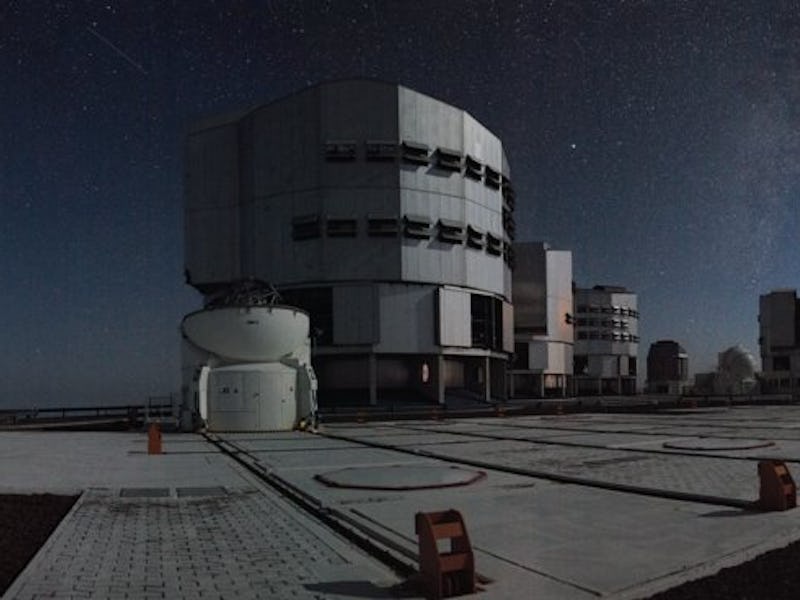Look: Scientists just discovered a gigantic planet that shouldn't exist
The odd planet challenges scientists’ ideas about planet formation.

A massive, odd planet was just discovered orbiting around two bright stars in the southern sky. It’s so weird that it’s challenging scientists’ ideas about how planets form and evolve.
b Centauri is a double star system that lies 325 light years away from Earth. The newly-discovered gas giant planet is 11 times as massive as Jupiter, with a vast orbit that’s 100 times wider than that of Jupiter’s — and strangely, it most likely formed there.
The astronomers who discovered the planet detail their findings in a study published Wednesday in the journal Nature. It marks the first discovery of a gas giant planet around a star that is more than three times the mass of the Sun, and around stars this hot.
Here’s the background — Markus Jonson and his team were using the SPHERE exoplanet imager on the European Southern Observatory’s Very Large Telescope in Paranal, Chile to survey the star system.
“I kind of went into it with a blank mind sort of speak,” Jonson tells Inverse. “I thought that there might be no planets around the stars, which would be interesting, but there might also be potentially plenty of planets around them, which would be even more interesting.”
The team was not only surprised to find a planet so early on in their survey, which took place between March 2019 and April 2021, but its features proved even more surprising.
The b Centauri system is composed of two stars — b Centauri A and b Centauri B. Combined, they weigh in at about six to 10 times the mass of the Sun. At this mass range, they should be too big to have a large planet. They’re also both hotter stars than we usually find planets around. The new finding changes what we know about planetary formation in a few ways.
The planet, bottom right, orbits both stars in the system.
What’s new — The planet, which they dubbed b Cen (AB)b, is 11 times the mass of Jupiter, the largest planet of the Solar System. The ratio between the mass of the newly discovered exoplanet and its stars is equivalent to the ratio between Jupiter’s mass and the Sun. It orbits the shared center of mass between both stars at 560 times the distance between Earth and the Sun. This orbit makes it 100 times more expansive than that of Jupiter. We only know of a few Solar System objects that orbit that far from the Sun.
“Everything about it is weird in some sense,” Jonson says.
One thing that’s not weird about it, though, is its past.
The planet’s orbit is relatively circular, meaning it had a calm upbringing. Most planets orbit their star in an elliptical orbit, which may have been caused by being tossed around by incoming asteroids or other space rocks that impacted the planets during their early history.
“This one maybe didn’t have so much a violent past — maybe it had a pretty calm past,” Jonson says. “So maybe it formed fairly close to where it was discovered today.”
The Centaurus constellation, which also includes Alpha Centauri.
Why it matters — Planets form from particles of gas and dust left over from the birth of stars. These particles collide together, creating larger and larger pieces until they result in the birth of a baby planet.
“This is such an extreme system that it gives very clear constraints under which conditions planets can form,” Jonson says.
The planet discovery challenges the timescale of planetary formation. These massive stars have high energy radiation, threatening the formation of a planet of such a giant size. Before this recent discovery, scientists believed that gas giant planets do not form around stars of this size.
“That means that it’s really hard to be able to form very rapidly,” Jonson says. “They wouldn’t have time to form before the disk goes away, so they don’t have anything to form it.”
The discovery also suggests that perhaps planets could form in a shorter period.
What’s next — the team is planning to conduct follow-up observations of the new exoplanet, especially that it makes for an ideal candidate due to its proximity to Earth. They have already sent out proposals to some of the largest telescopes out there to find out more about the atmosphere of the planet and its other characteristics.
Abstract —Planet formation occurs around a wide range of stellar masses and stellar system architectures1 . An improved understanding of the formation process can be achieved by studying it across the full parameter space, particularly towards the extremes. Earlier studies of planets in close-in orbits around high-mass stars have revealed an increase in giant planet frequency with increasing stellar mass2 until a turnover point at 1.9 solar masses (M⊙), above which the frequency rapidly decreases3 . This could potentially imply that planet formation is impeded around more massive stars, and that giant planets around stars exceeding 3 M⊙ may be rare or non-existent. However, the methods used to detect planets in small orbits are insensitive to planets in wide orbits. Here we demonstrate the existence of a planet at 560 times the Sun–Earth distance from the 6- to 10-M⊙ binary b Centauri through direct imaging. The planet-to-star mass ratio of 0.10–0.17% is similar to the Jupiter–Sun ratio, but the separation of the detected planet is about 100 times wider than that of Jupiter. Our results show that planets can reside in much more massive stellar systems than what would be expected from extrapolation of previous results. The planet is unlikely to have formed in situ through the conventional core accretion mechanism4 , but might have formed elsewhere and arrived to its present location through dynamical interactions, or might have formed via gravitational instability.
This article was originally published on